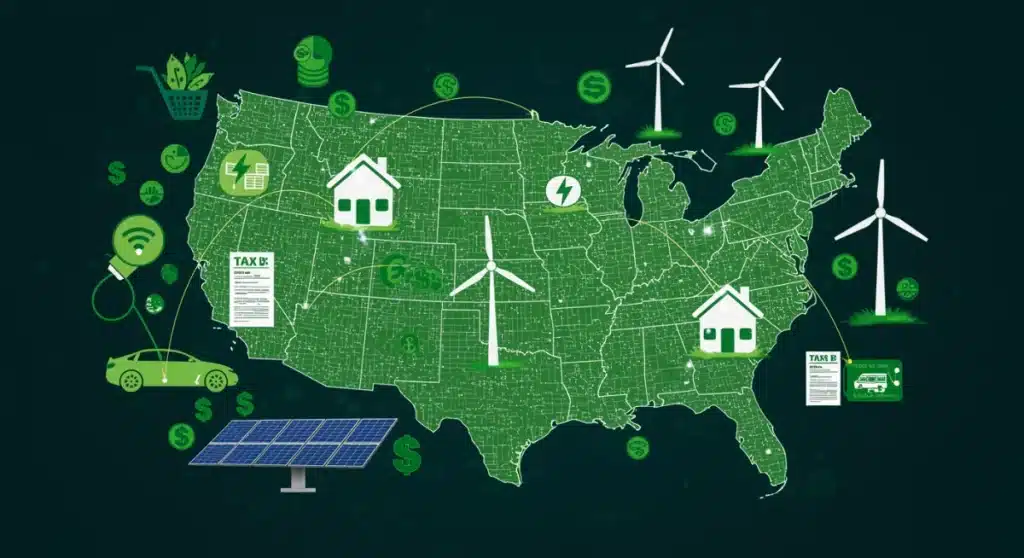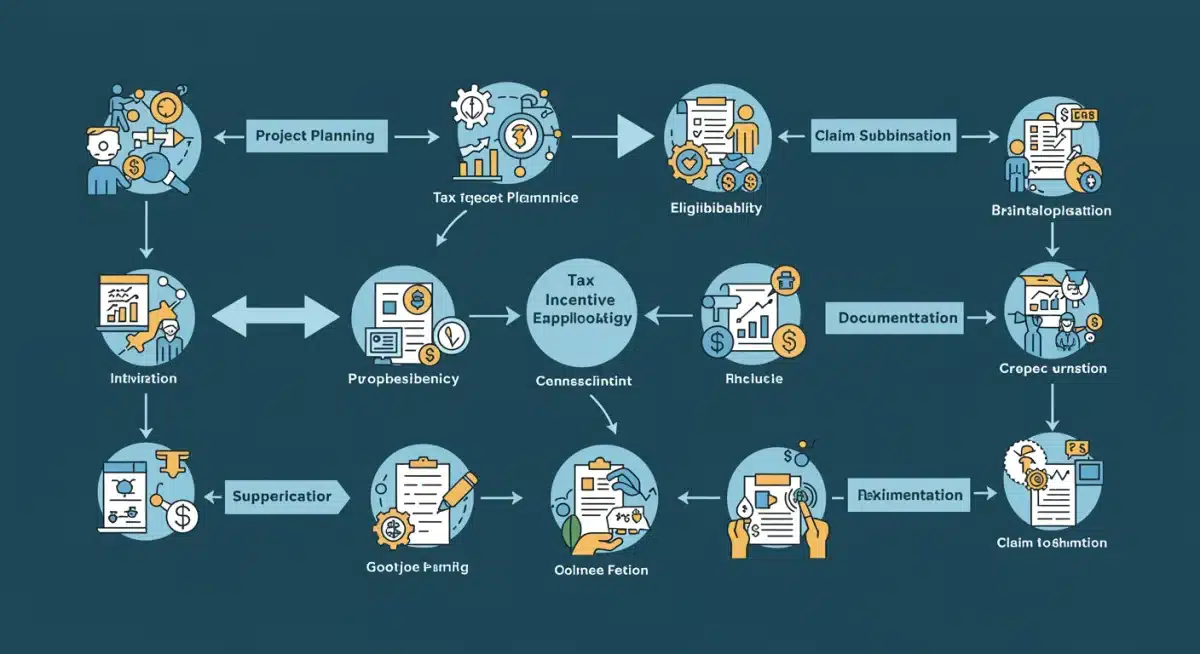Decoding 2025 US Green Tech Tax Incentives: Your Checklist

Decoding the 2025 US Green Tech Tax Incentives: A 10-Point Checklist (FINANCIAL IMPACT, PRACTICAL SOLUTIONS) provides essential guidance for businesses and individuals to navigate upcoming financial opportunities in sustainable technology.
As the United States accelerates its transition to a greener economy, understanding the evolving landscape of tax incentives is paramount. Decoding the 2025 US Green Tech Tax Incentives: A 10-Point Checklist (FINANCIAL IMPACT, PRACTICAL SOLUTIONS) offers crucial insights for businesses and individuals aiming to capitalize on these significant financial opportunities. This guide provides immediate, actionable information to prepare for the upcoming changes.
Understanding the Legislative Framework for 2025
The legislative foundation for 2025 green tech tax incentives is largely rooted in existing acts, with specific provisions slated for activation or modification. These policies aim to drive investment and adoption across renewable energy, energy efficiency, and sustainable transportation sectors. Businesses and homeowners must grasp the underlying laws to effectively plan for upcoming opportunities.
Recent updates from the Treasury Department, as of late October, confirm the continued emphasis on domestic content requirements and prevailing wage provisions for many credits. This ensures that the economic benefits of green tech expansion are felt within the US economy. The focus remains on robust, long-term growth in the clean energy sector.
Key Legislative Pillars
The Inflation Reduction Act (IRA) of 2022 remains the cornerstone, with many of its tax credit provisions extending through 2025 and beyond. These provisions cover a broad spectrum of green technologies and projects. Understanding specific sections of the IRA is the first step toward unlocking these benefits.
- Section 45Y Clean Electricity Production Credit: Replacing older credits, this offers a technology-neutral credit for electricity production from clean sources.
- Section 45Z Clean Fuel Production Credit: Incentivizes the domestic production of clean fuels with significantly reduced lifecycle greenhouse gas emissions.
- Section 48 Investment Tax Credit (ITC): Continues to provide substantial credits for investments in renewable energy property, including solar and wind.
Eligibility Criteria: Who Qualifies for Incentives?
Determining eligibility is the critical second step in leveraging the 2025 green tech tax incentives. The criteria can vary significantly based on the type of incentive, the project’s scope, and the entity applying for the credit. Both individuals and various business structures are targeted, but specific conditions apply to each.
For businesses, factors such as project size, location, and adherence to labor standards (like prevailing wages and apprenticeship requirements) are often paramount. Individual homeowners typically face criteria related to the installation of qualified energy-efficient improvements or renewable energy systems on their primary residences. The IRS has been issuing guidance to clarify these complex requirements.
Business Eligibility Factors
Corporate entities, non-profits, and even governmental organizations can often directly claim or transfer these credits. The structure of the entity and its tax liability play a significant role. Small businesses, in particular, have access to certain direct pay options.
- Project Scale: Larger utility-scale projects often have more stringent requirements but also higher potential credit values.
- Domestic Content: A growing number of incentives mandate a percentage of components be sourced domestically to qualify for enhanced credit rates.
- Labor Standards: Meeting prevailing wage and apprenticeship requirements is crucial for maximizing many production and investment tax credits.
Maximizing Financial Impact: Direct Pay and Transferability
The 2025 incentives introduce groundbreaking mechanisms like direct pay and transferability, fundamentally altering how entities can monetize tax credits. These provisions are designed to expand access to incentives beyond traditional tax-equity investors, benefiting a wider array of organizations.
Direct pay allows tax-exempt organizations, state and local governments, and certain other entities to receive the value of credits as a refund, even if they have no tax liability. Transferability, on the other hand, permits eligible taxpayers to sell their credits to unrelated third parties for cash. This flexibility is a game-changer for project financing.
Strategic Utilization of New Mechanisms
Understanding the nuances of direct pay and transferability is vital for optimizing financial outcomes. Businesses should evaluate which mechanism best suits their financial structure and project goals. This strategic decision can significantly impact project viability and return on investment.
- Direct Pay for Tax-Exempts: Non-profits and public entities can now directly receive the cash equivalent of tax credits, removing the need for complex tax equity structures.
- Credit Transferability: Businesses with insufficient tax liability can sell their excess credits, providing a new source of capital for green tech projects.
- Market Dynamics: A robust market for transferable tax credits is emerging, offering liquidity and efficiency for credit monetization.
Key Green Technologies Covered by Incentives
The scope of eligible green technologies under the 2025 incentives is broad, reflecting a comprehensive approach to decarbonization. This includes well-established renewable energy sources, emerging clean technologies, and energy efficiency upgrades. Staying informed about the specific technologies covered is essential for project development.
Solar and wind power continue to be major beneficiaries, with incentives supporting both utility-scale and distributed generation projects. Battery storage, electric vehicle charging infrastructure, and hydrogen production are also strongly incentivized. Home energy efficiency improvements, such as heat pumps and insulation, receive significant boosts for individual homeowners.

Navigating the Application and Documentation Process
Successfully claiming green tech tax incentives requires meticulous attention to the application and documentation process. This often involves pre-registration, detailed record-keeping, and accurate reporting to the IRS. Inadequate preparation can lead to delays or the forfeiture of valuable credits.
Project developers must register their projects with the IRS before construction begins, particularly for larger commercial projects. Comprehensive documentation of costs, labor hours, and component sourcing is critical for substantiating credit claims. The IRS has emphasized the importance of maintaining clear, auditable records for all qualifying expenditures.
Essential Documentation Requirements
Each incentive program has specific documentation guidelines. It is crucial to consult the latest IRS guidance and professional tax advisors to ensure compliance. Early and continuous record-keeping is a best practice for all projects.
- Cost Basis Documentation: Detailed records of all eligible project costs, including equipment, installation, and associated services.
- Labor Records: For projects subject to prevailing wage and apprenticeship requirements, meticulous documentation of payroll and apprentice hours is mandatory.
- Domestic Content Certification: Proof of origin for components, if claiming enhanced domestic content adders.
Future Outlook and Potential Policy Adjustments
The landscape of green tech tax incentives is dynamic, with potential for future policy adjustments and clarifications. While the core framework for 2025 is largely set, ongoing regulatory guidance and potential legislative tweaks could influence implementation. Stakeholders must remain vigilant for any emerging changes.
Recent discussions in Congress have touched upon potential technical corrections to existing legislation, though major overhauls are not anticipated in the immediate future. The Treasury and IRS continue to issue updated notices and FAQs, providing crucial clarifications on various aspects of the incentives. These updates are vital for accurate planning and compliance.
Anticipating Regulatory Changes
Businesses and individuals should monitor official government publications and industry news closely. Engaging with professional associations and tax experts can also provide early warnings of potential shifts. Proactive adaptation to regulatory changes can safeguard planned investments.
- IRS Guidance: Regularly check the IRS website for new notices, proposed regulations, and final rules related to green energy tax credits.
- Congressional Action: While less frequent, legislative amendments can occur, particularly as the effectiveness of current policies is evaluated.
- Industry Advocacy: Trade associations often lobby for clarifications or expansions of incentives, which can influence future policy.
| Key Incentive | Brief Description |
|---|---|
| Clean Electricity Production Credit (45Y) | Technology-neutral credit for clean electricity generation, replacing older production tax credits. |
| Investment Tax Credit (48) | Provides credits for investments in qualified renewable energy property, including solar and wind. |
| Direct Pay Option | Allows tax-exempt entities to receive tax credit value as a direct cash payment from the IRS. |
| Credit Transferability | Enables eligible taxpayers to sell their federal clean energy tax credits to unrelated third parties. |
Frequently Asked Questions About 2025 Green Tech Incentives
The primary goal is to accelerate the transition to a clean energy economy by incentivizing investments in renewable energy, energy efficiency, and sustainable technologies. This aims to reduce greenhouse gas emissions, create jobs, and enhance energy independence across the United States through financial benefits.
Direct pay allows tax-exempt entities to receive cash refunds for credits, while transferability lets taxable entities sell credits for cash. Both mechanisms significantly broaden access to incentive benefits, de-risking projects and attracting a wider range of investors beyond traditional tax equity markets, thus boosting project financing.
Yes, residential homeowners are eligible for various incentives, primarily through tax credits for installing qualified energy-efficient home improvements and residential clean energy property. These include solar panels, heat pumps, and other energy-saving upgrades, promoting sustainability at the individual household level.
Crucial documentation includes detailed records of all eligible project costs, proof of labor compliance (for prevailing wage/apprenticeship requirements), and, if applicable, certification of domestic content for components. Accurate and thorough record-keeping is essential to substantiate claims and avoid audit issues with the IRS.
Businesses should regularly monitor official IRS guidance, Treasury Department announcements, and industry-specific news outlets. Consulting with tax professionals specializing in green energy and engaging with relevant trade associations are also effective strategies to stay informed about any evolving policy adjustments or clarifications.
What Happens Next
As 2025 approaches, the focus shifts to the practical implementation of these green tech tax incentives. Businesses and individuals should prioritize early planning and consultation with tax and legal professionals to ensure full compliance and maximize potential benefits. The ongoing release of IRS guidance will continue to refine the application process, making continuous monitoring essential. These incentives are poised to reshape investment priorities, driving innovation and sustainable growth across the US economy. Expect continued emphasis on domestic manufacturing and job creation as these policies mature.





